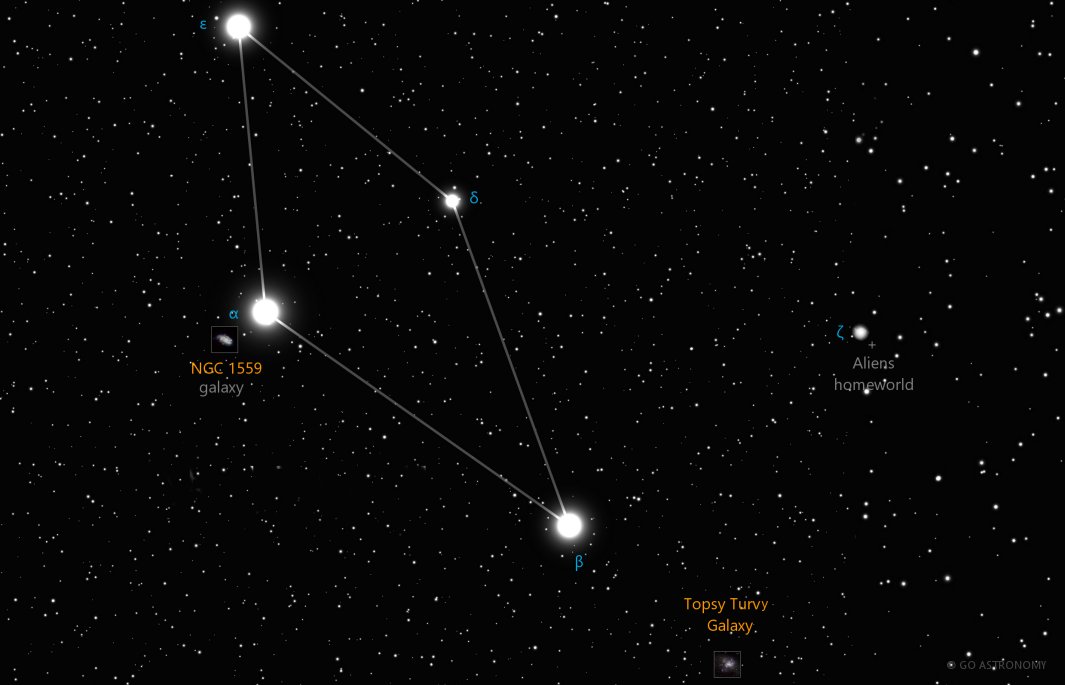Reticulum, the Net (Reticle) (Ret)
(rih-TICK-yuh-lum)
The Southern constellation of Reticulum, the Net (Reticle), is best viewed in Winter during the month of January.
Reticulum is the 82nd largest constellation. It's brightest star is Alpha Reticuli at magnitude 3.33. The boundary of the Reticulum constellation contains 8 stars that host known exoplanets.
Reticulum is a circumpolar constellation, so is visible year-round in the Southern hemisphere. Conversely, it is not visible in the opposite hemisphere.
- Pronunciation:
- rih-TICK-yuh-lum
- Meaning:
- Net (Reticle)
- Genitive:
- Reticuli
- Abbreviation:
- Ret
- Constellation Family:
- LaCaille
- Hemisphere:
- Southern
- Quadrant:
- SQ1
- Visibility:
- 23° N - 90° S
- Best viewing month*:
- January
- Area:
- 114 sq. degrees
- Size:
- 82nd largest
- Circumpolar** (N=northern, S=southern):
- S circumpolar
- Right Ascension (avg):
- 3h 54m
- Declination (avg):
- -62°
- Brightest star:
- Alpha Reticuli (3.33)
- Stars with planets:
- 8
- Messier objects:
- |
- Caldwell objects:
- |
Brightest Stars in Reticulum
The 10 brightest stars in the constellation Reticulum by magnitude.
- Star
- Magnitude
- Spectral class
- Alpha Reticuli (α Ret)
- 3.33
- G7III
- Beta Reticuli (β Ret)
- 3.84
- K0IV SB
- Epsilon Reticuli (ε Ret)
- 4.44
- K2IV
- Gamma Reticuli (γ Ret)
- 4.48
- M4III
- Delta Reticuli (δ Ret)
- 4.56
- M2III
- Kappa Reticuli (κ Ret)
- 4.71
- F5IV-V
- Iota Reticuli (ι Ret)
- 4.97
- K4III
- Zeta Reticuli (ζ2 Ret)
- 5.24
- G1V
- Eta Reticuli (η Ret)
- 5.24
- G7III
- HD 27304
- 5.45
- K0III
Galaxies in Reticulum
The most notable galaxies in the constellation Reticulum. Also see all galaxies.
- Name
- Alt name
- Type
- IC 2056
- spiral
- NGC 1543
- lenticular
- NGC 1559
- spiral
- NGC 1574
- elliptical
- Topsy Turvy Galaxy
- starburst
Milky Way Satellites in Reticulum
Dwarf satellite galaxies that orbit the Milky Way Galaxy located in the constellation Reticulum. Also see all Milky Way satellite galaxies.
- Galaxy name
- Alt name
- Magnitude
- Reticulum II
- Reticulum III
The Celestial Reticle
Reticulum, Latin for "reticle" or "net", is a minor and faint constellation located in the Southern Celestial Hemisphere. The constellation, representing the reticle ? a grid in the eyepiece of a measuring instrument, was first introduced to the scientific community in the 18th century.
Historical Background
Reticulum was one of fourteen constellations created by the French astronomer Nicolas Louis de Lacaille during his stay at the Cape of Good Hope from 1750 to 1754. It was initially named le R?ticule Rhomboide to denote the reticle in an eyepiece, a tool that Lacaille regularly used in his observations. The name was later shortened to Reticulum. It is the only constellation that symbolizes a specific tool used by astronomers, paying homage to the advancements in observational tools that significantly contributed to modern astronomy.
Location and Visibility
Reticulum is nestled between the constellations of Dorado and Horologium in the southern sky. With a declination of about -60 degrees, Reticulum is best observed from the Southern Hemisphere during the summer months. The constellation spans approximately 114 square degrees, making it the 82nd largest constellation in terms of size. Despite its modest size and faint stars, Reticulum offers some intriguing celestial sights for the patient observer.
Main Stars in Reticulum
Comprising mostly of faint stars, Reticulum's brightest star, Alpha Reticuli, is a binary star system located approximately 39.4 light-years away from the Earth. It consists of two G-type stars, somewhat similar to our Sun but older. Beta Reticuli, the second brightest star, is an orange giant situated about 100 light-years away, while Gamma Reticuli is a yellow giant that lies approximately 470 light-years distant.
Deep Sky Objects
One of Reticulum's most compelling features is its deep-sky objects. It is home to the spiral galaxy NGC 1559, an intermediate spiral galaxy with an apparent magnitude of 11.4 that features two prominent arms. Also, the constellation contains a group of galaxies called the Reticulum Cluster. This galaxy cluster is located around 200 million light-years away and holds many galaxies within its grasp.
Observation
Reticulum's stars are relatively faint, making it a challenge to locate without the help of a star chart or an application. However, once found, it provides an excellent opportunity for stargazers and astronomers to observe and study its deep-sky objects. Locating the bright star Achernar in the constellation Eridanus can provide a guide, as Reticulum lies to the southeast of this star. For the best views, a location with minimal light pollution is recommended.
* Constellation shown for northen hemisphere skies. For the southern hemisphere, constellations appear rotated 180 degrees (upside-down and left-right reversed) from what is shown. Remember that seasons are reversed too - summer in northern latitudes is winter in southern latitudes.
** Circumpolar constellations are visible year-round in the hemisphere listed (and not at all in the opposite hemisphere).





